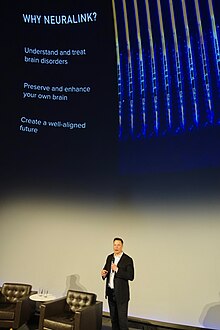Neuralink
| Neuralink
|
|
|---|---|
| legal form | Private |
| founding | July 2016 |
| Seat |
San Francisco , United States |
| management | Elon Musk (CEO) |
| Number of employees | Around 100 (as of August 2020) |
| Branch | Brain-computer interface , neuroprostheses |
| Website | neuralink.com |
| As of September 6, 2017 | |
Neuralink is an American neurotechnology company founded in July 2016 by Elon Musk and eight other people. The aim of Neuralink is to develop a device for communication between the human brain and computers , a so-called brain-computer interface (BCI).
history

Neuralink was founded in 2016 by Elon Musk, who is known for his work at Tesla and SpaceX , as well as by Ben Rapoport, Dongjin Seo, Max Hodak, Paul Merolla, Philip Sabes, Tim Gardner, Tim Hanson and Vanessa Tolosa. Neuralink is based in San Francisco , California , USA. The company acquired the rights to the “Neuralink” brand in January 2017 from two neuroscientists .
Neuralink was first reported publicly in March 2017. On July 16, 2019, the company reported on its progress as part of a live stream. Another live demonstration on August 29, 2020, which was primarily intended to be used to recruit staff , was intended to demonstrate the unrestricted removal and interchangeability of the invasive BCI on experimental pigs. In addition, the resolution of the more than 1000 channels was to be demonstrated, with which the reading out of all essential joint positions of the pigs in motion had become possible. The full range of psychopathological findings should also be addressed through active BCI functions. There are already steps in the FDA - approval process have been made.
aims
The short-term goal of Neuralink is to be able to better treat serious diseases of the brain and the central nervous system . Long-term goals include, among other things, the technical expansion of the human body ("human enhancement") in order to keep pace with advances in the development of artificial intelligence or to be able to "combat potentially dangerous uses of artificial intelligence."
“To a scientist, to think about changing the fundamental nature of life — creating viruses, eugenics, etc. — it raises a specter that many biologists find quite worrisome, whereas the neuroscientists that I know, when they think about chips in the brain, it doesn't seem that foreign, because we already have chips in the brain. We have deep brain stimulation to alleviate the symptoms of Parkinson's Disease, we have early trials of chips to restore vision, we have the cochlear implant — so to us it doesn't seem like that big of a stretch to put devices into a brain to read information out and to read information back in. "
According to the Progress Update in summer 2020, a first, ethically justifiable step for Musk is to strive for functionalities in the field of "consensual telepathy" ( consensus-based telepathy ).
implementation
The brain-computer interface should be implemented using electrodes that are implanted in the brain. So it is an invasive neuroprosthesis .
reception
Ulrich Dirnagl , Director of the Experimental Neurology Department at the Charité Berlin , sees the promises made by Neuralink as dubious hype; Philipp Kellmeyer, a specialist in neurology at the Freiburg University Medical Center, makes a similar judgment . The German communication scientist Miriam Meckel criticized Musk employing his company Neuralink to network human brains in a brain cloud enriched with artificial intelligence . The individual thoughts would then be available to everyone who connects to this cloud . Meckel warns that such a development would result in almost unlimited access to the innermost core of the individual personality.
Web links
Individual evidence
- ↑ ssu / dpa-AFX : Neuralink: Tesla boss wants to network brains with computers. In: SpOn , March 28, 2017.
- ^ Hyacinth Mascarenhas: Elon Musk plans to merge human brain with computers for 'consensual telepathy' . In: International Business Times UK . April 21, 2017 ( ibtimes.co.uk [accessed September 22, 2017]).
- ↑ Elon Musk's Neuralink wants to turn cloud-based AI into an extension of our brains. In: techcrunch.com. TechCrunch , April 20, 2017, accessed September 6, 2017 .
- ↑ Neuralink presentation , August 28, 2020
- ↑ a b c d Neuralink and the Brain's Magical Future. In: waitbutwhy.com. Wait But Why , April 20, 2017, accessed September 6, 2017 .
- ↑ Meet the Guys Who Sold “Neuralink” to Elon Musk without Even Realizing It. In: technologyreview.com. Technology Review , April 4, 2017, accessed September 6, 2017 .
- ↑ Elon Musk Launches Neuralink to Connect Brains With Computers. In: wsj.com. The Wall Street Journal , March 27, 2017, accessed September 6, 2017 .
- ↑ Elon Musk launches Neuralink, a venture to merge the human brain with AI. In: theverge.com. The Verge , March 27, 2017, accessed September 6, 2017 .
- ↑ Elon Musk and Neuralink: Tesla boss wants to network brains with computers. In: spiegel.de. SPIEGEL ONLINE GmbH , March 28, 2017, accessed on September 6, 2017 .
- ↑ Neuralink: Elon Musk wants to link the brain with computers. In: handelsblatt.com. Handelsblatt GmbH, March 27, 2017, accessed on September 6, 2017 .
- ↑ Neuralink: Neuralink live streaming. July 16, 2019, accessed July 17, 2019 .
- ↑ a b Neuralink Progress Update, Summer 2020. In: YouTube. Neuralink, August 29, 2020, accessed on August 29, 2020 .
- ↑ a b Neuralink: Elon Musk wants brain-computer interfaces evolve. In: golem.de. Golem Media GmbH , March 28, 2017, accessed on September 6, 2017 .
- ^ A quick guide to Elon Musk's new brain-implant company, Neuralink. In: latimes.com. Los Angeles Times , April 21, 2017, accessed September 6, 2017 .
- ↑ heise online: Neurologists to Elon Musk: Neuralink's brain implant is "dubious hype". Retrieved July 28, 2019 .
- ↑ Miriam Meckel: The spy in my head. Technology companies want to penetrate into our brain. If they succeed, the freedom of our thoughts is at stake. In: Die Zeit , April 12, 2018, p. 36, online , accessed on November 21, 2019

